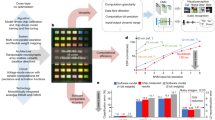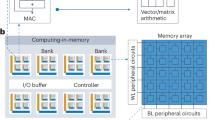Abstract
Computation-in-memory (CIM) chips offer an energy-efficient approach to artificial intelligence computing workloads. Resistive random-access memory (RRAM)-based CIM chips have proven to be a promising solution for overcoming the von Neumann bottleneck. In this paper, we review our recent studies on the architecture-circuit-technology co-optimization of scalable CIM chips and related hardware demonstrations. To further minimize data movements between memory and computing units, architecture optimization methods have been introduced. Then, we propose a device-architecture-algorithm co-design simulator to provide guidelines for designing CIM systems. A physics-based compact RRAM model and an array-level analog computing model were embedded in the simulator. In addition, a CIM compiler was proposed to optimize the on-chip dataflow. Finally, research perspectives are proposed for future development.
Similar content being viewed by others
References
Xu X, Ding Y, Hu S X, et al. Scaling for edge inference of deep neural networks. Nat Electron, 2018, 1: 216–222
Zhang W Q, Gao B, Tang J S, et al. Neuro-inspired computing chips. Nat Electron, 2020, 3: 371–382
Zou X Q, Xu S, Chen X M, et al. Breaking the von Neumann bottleneck: architecture-level processing-in-memory technology. Sci China Inf Sci, 2021, 64: 160404
Zidan M A, Strachan J P, Lu W D. The future of electronics based on memristive systems. Nat Electron, 2018, 1: 22–29
Yao P, Wu H Q, Gao B, et al. Fully hardware-implemented memristor convolutional neural network. Nature, 2020, 577: 641–646
Ren Y M, Tian B B, Yan M G, et al. Associative learning of a three-terminal memristor network for digits recognition. Sci China Inf Sci, 2023, 66: 122403
Prezioso M, Merrikh-Bayat F, Hoskins B D, et al. Training and operation of an integrated neuromorphic network based on metal-oxide memristors. Nature, 2015, 521: 61–64
Jiang Y N, Huang P, Zhou Z, et al. Circuit design of RRAM-based neuromorphic hardware systems for classification and modified Hebbian learning. Sci China Inf Sci, 2019, 62: 62408
Zhao M R, Gao B, Tang J S, et al. Reliability of analog resistive switching memory for neuromorphic computing. Appl Phys Rev, 2020, 7: 011301
Han R Z, Huang P, Zhao Y D, et al. Efficient evaluation model including interconnect resistance effect for large scale RRAM crossbar array matrix computing. Sci China Inf Sci, 2019, 62: 022401
Chen P Y, Peng X C, Yu S M. NeuroSim: a circuit-level macro model for benchmarking neuro-inspired architectures in online learning. IEEE Trans Comput-Aided Des Integr Circ Syst, 2018, 37: 3067–3080
Peng X C, Huang S S, Luo Y D, et al. DNN+NeuroSim: an end-to-end benchmarking framework for compute-in-memory accelerators with versatile device technologies. In: Proceedings of IEEE International Electron Devices Meeting (IEDM), 2019
Xia L X, Li B X, Tang T Q, et al. MNSIM: simulation platform for memristor-based neuromorphic computing system. In: Proceedings of Design, Automation & Test in Europe Conference & Exhibition (DATE), 2016. 469–474
Zhu Z H, Sun H B, Qiu K Z, et al. MNSIM 2.0: a behavior-level modeling tool for memristor-based neuromorphic computing systems. In: Proceedings of the Great Lakes Symposium on VLSI, 2020. 83–88
Yu R H, Zhang W Q, Gao B, et al. CLEAR: a full-stack chip-in-loop emulator for analog RRAM based computing-in-memory system. Sci China Inf Sci, 2023. doi: https://doi.org/10.1007/s11432-022-3756-3
Yao P, Wu H Q, Gao B, et al. Face classification using electronic synapses. Nat Commun, 2017, 8: 15199
Gao B, Zhou Y, Zhang Q T, et al. Memristor-based analogue computing for brain-inspired sound localization with in situ training. Nat Commun, 2022, 13: 2026
Zhou Y, Gao B, Zhang Q T, et al. Application of mathematical morphology operation with memristor-based computation-in-memory architecture for detecting manufacturing defects. Fundamental Res, 2022, 2: 123–130
Liu Q, Gao B, Yao P, et al. A fully integrated analog ReRAM based 78.4TOPS/W compute-in-memory chip with fully parallel MAC computing. In: Proceedings of IEEE International Solid-State Circuits Conference (ISSCC), 2020. 500–502
Lin Y, Hu X S, Qian H, et al. Bayesian neural network realization by exploiting inherent stochastic characteristics of analog RRAM. In: Proceedings of IEEE International Electron Devices Meeting (IEDM), 2019
Qin Q, Gao B, Liu Q, et al. Hybrid precoding with a fully-parallel large-scale analog RRAM array for 5G/6G MIMO communication system. In: Proceedings of International Electron Devices Meeting (IEDM), 2022
Li X Q, Gao B, Lin B H, et al. First demonstration of homomorphic encryption using multi-functional RRAM arrays with a novel noise-modulation scheme. In: Proceedings of International Electron Devices Meeting (IEDM), 2022
Liu Z W, Tang J S, Gao B, et al. Neural signal analysis with memristor arrays towards high-efficiency brain-machine interfaces. Nat Commun, 2020, 11: 4234
Zhang W Q, Gao B, Yao P, et al. Array-level boosting method with spatial extended allocation to improve the accuracy of memristor based computing-in-memory chips. Sci China Inf Sci, 2021, 64: 160406
Liao Y, Gao B, Yao P, et al. Diagonal matrix regression layer: training neural networks on resistive crossbars with interconnect resistance effect. IEEE Trans Comput-Aided Des Integr Circ Syst, 2021, 40: 1662–1671
Liao Y, Gao B, Zhang W Q, et al. Parasitic resistance effect analysis in RRAM-based TCAM for memory augmented neural networks. In: Proceedings of IEEE International Memory Workshop (IMW), 2020. 1–4
Liu Y Y, Zhao M R, Gao B, et al. Compact reliability model of analog RRAM for computation-in-memory device-to-system codesign and benchmark. IEEE Trans Electron Dev, 2021, 68: 2686–2692
Shulaker M M, Hills G, Park R S, et al. Three-dimensional integration of nanotechnologies for computing and data storage on a single chip. Nature, 2017, 547: 74–78
Sabry A M M, Wu T F, Bartolo A, et al. The N3XT approach to energy-efficient abundant-data computing. Proc IEEE, 2019, 107: 19–48
Hwang W, Wan W, Mitra S, et al. Coming up N3XT, after 2D scaling of Si CMOS. In: Proceedings of IEEE International Symposium on Circuits and Systems (ISCAS), 2018. 1–5
An R, Li Y J, Tang J S, et al. A hybrid computing-in-memory architecture by monolithic 3D integration of BEOL CNT/IGZO-based CFET logic and analog RRAM. In: Proceedings of International Electron Devices Meeting (IEDM), 2022
Li Y J, Tang J S, Gao B, et al. Monolithic 3D integration of logic, memory and computing-in-memory for one-shot learning. In: Proceedings of IEEE International Electron Devices Meeting (IEDM), 2021
Zhang W Q, Peng X C, Wu H Q, et al. Design guidelines of RRAM based neural-processing-unit: a joint device-circuit-algorithm analysis. In: Proceedings of the 56th Annual Design Automation Conference, 2019. 1–6
Liu Y Y, Gao B. System and technology co-optimization for RRAM based computation-in-memory chip. In: Proceedings of International Conference on IC Design and Technology (ICICDT), 2021. 1–4
Liu Y Y, Gao B, Xu F, et al. A compact model for relaxation effect in analog RRAM for computation-in-memory system design and benchmark. In: Proceedings of the 5th IEEE Electron Devices Technology & Manufacturing Conference (EDTM), 2021. 1–3
Liao Y, Gao B, Xu F, et al. A compact model of analog RRAM with device and array nonideal effects for neuromorphic systems. IEEE Trans Electron Dev, 2020, 67: 1593–1599
Wu W, Wu H Q, Gao B, et al. A methodology to improve linearity of analog RRAM for neuromorphic computing. In: Proceedings of IEEE Symposium on VLSI Technology, 2018. 103–104
Ma A W, Gao B, Liu Y Y, et al. Multi-scale thermal modeling of RRAM-based 3D monolithic-integrated computing-in-memory chips. In: Proceedings of International Electron Devices Meeting (IEDM), 2022
Jiang H W, Huang S S, Li W T, et al. ENNA: an efficient neural network accelerator design based on ADC-free compute-in-memory subarrays. IEEE Trans Circ Syst I, 2023, 70: 353–363
Li W T, Xu P F, Zhao Y, et al. TIMELY: pushing data movements and interfaces in pim accelerators towards local and in time domain. In: Proceedings of the 47th Annual International Symposium on Computer Architecture (ISCA), 2020. 832–845
Chou T, Tang W, Botimer J, et al. CASCADE: connecting RRAMs to extend analog dataflow in an end-to-end in-memory processing paradigm. In: Proceedings of the 52nd Annual IEEE/ACM International Symposium on Microarchitecture (MICRO), 2019. 114–125
Ueyoshi K, Papistas I A, Houshmand P, et al. DIANA: an end-to-end energy-efficient digital and analog hybrid neural network SoC. In: Proceedings of IEEE International Solid-State Circuits Conference (ISSCC), 2022. 1–3
Acknowledgements
This work was supported by National Natural Science Foundation of China (Grant Nos. 92064001, 62025111, 92264201) and Beijing Advanced Innovation Center for Integrated Circuits.
Author information
Authors and Affiliations
Corresponding author
Rights and permissions
About this article
Cite this article
Liu, Y., Gao, B., Tang, J. et al. Architecture-circuit-technology co-optimization for resistive random access memory-based computation-in-memory chips. Sci. China Inf. Sci. 66, 200408 (2023). https://doi.org/10.1007/s11432-023-3785-8
Received:
Revised:
Accepted:
Published:
DOI: https://doi.org/10.1007/s11432-023-3785-8




